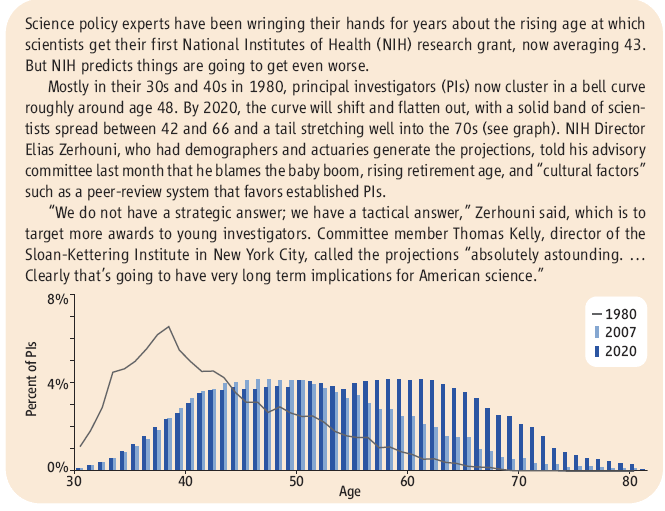|
|
|
|
|
|
|
News & Views item - January 2008 |
![]() A Conspiracy of Stagnation? (January 25, 2008)
A Conspiracy of Stagnation? (January 25, 2008)
The US National Institutes of Health Director, Elias Zerhouni, has enlisted demographers and actuaries to predict the ageing of the Institutes' future principal investigators (PI), and if you're a young scientist looking to funding in order to develop your own research initiatives, the news isn't good.
During the 1980's PIs were in the 30 to 40 age bracket. Today Science reports they cluster around 48 and "by 2020, the curve will shift and flatten out, with a solid band of scientists spread between 42 and 66 and a tail stretching well into the 70s"
To state the obvious the system of determining the awarding of NIH grants favours those who are previous grantees, i.e. they've got runs on the board and when funds are tight, the tendency is to play a conservative game.
Clearly relying heavily on citation metrics will exacerbate such a conservative approach (lower risk of drawing criticism for poor funding choices).
But is it in the best interest of the country to effectively stifle the up coming generation? This is of particular concern when prospects of support are seen to be better overseas.
Australia's National Health and Medical Research Council is in consultation with the NIH with a view to improving how it implements its peer review process for research grants. Surely this ought to be the starting point for the Minister for Innovation, Industry, Science and Research to develop a sound and forward looking approach for the distribution of research funds. The metrics based approach with its potential for heavy reliance on citation indices holds the potential for what might be termed a cheap and nasty approach.

Taken from
Science, 25 January 2008
Adapted from the NIH